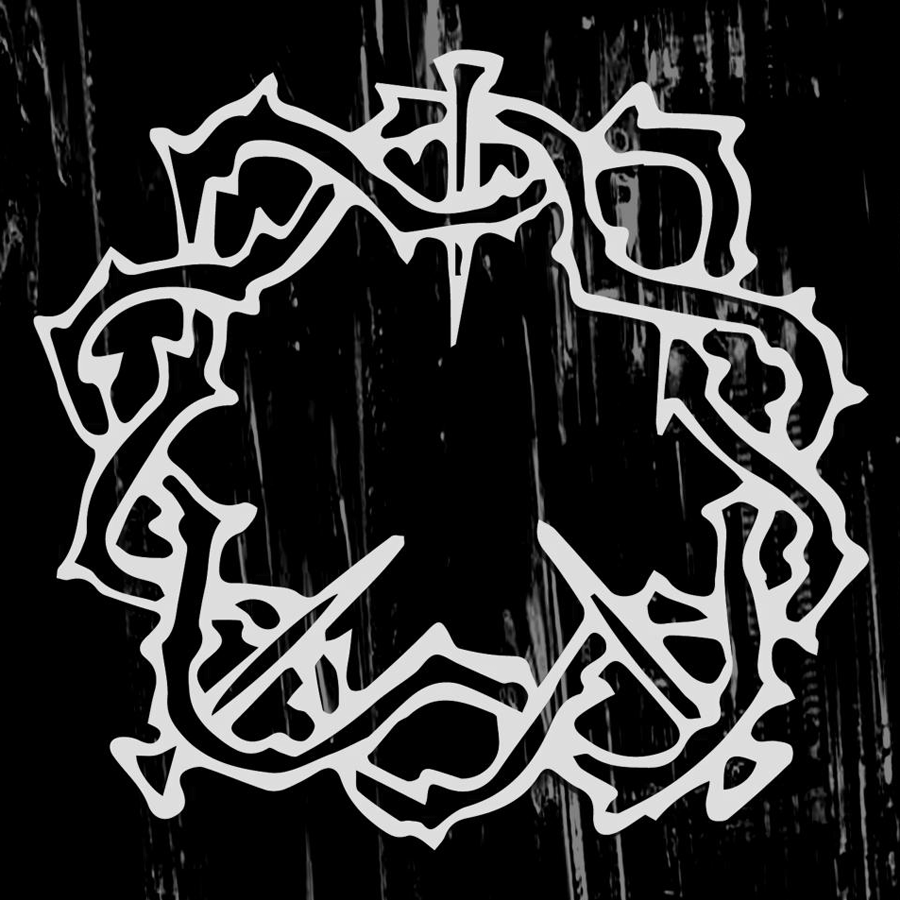
13 Mar Classified Information – The Vatican Shadow Files
Dominick Fernow, a multimedia artist and the New York City’s Hospital Productions boss, embodies a definition of a modern day polymath. Over the years, Fernow has been involved in countless (self-initiated) projects: most notably in noise-inflicted Doom Electronics of Prurient, conspiratorial Techno of Vatican Shadow, a witch-hunting death dub of Rainforest Spiritual Enslavement, black metal nihilism of Ash Pool and many more (listed at the end of this article), all together in his mission to keep the underground alive. It’s a calling and an act of necessity after all.
“My work was never intended to stand alone but rather become a cumulation of ’research’ (smaller releases focussing on specific content and sounds) and the result of this research would be called ‘albums’ which deal less in specifics and incorporates the wider spectrum of that research.” (The Quietus, 2020)
However, instead of doing an impossible Sisyphus’ work of trying to capture his whole discography (and thus missing the point), I will laser focus on Vatican Shadow, Fernow’s “militant religious industrial – music for assassins on the world-scale board game upon which it isn’t clear who is winning or what side you are on.” Or his ‘dance project‘ if you like…
The article is divided into several sections; part one introduces the Vatican Shadow to those who may not be familiar with it, part two presents (what I find to be) the four key takeaways from Vatican Shadow’s practice, the third part is a *cheat sheet* dissecting his musical opus through what I see as the five main phases. Finally, the parts four and five is content reserved for those who join my [free] mailing-list, as well as encouraging some further research.
Part One:
Behind the shadow

Vatican Shadow’s groundwork had been laid a decade ago, simultaneously with creation of Prurient’s *Los Angeles trilogy* (Bermuda Drain, Time’s Arrow, Through The Window), when Fernow had been touring Europe, listening to minimal techno, learning MIDI programming and experimenting with making beats (while driving at night through tunnels). Even though foundation was same, the intent was different.
“Monikers are simply a reflection of content and contextual starvation. If I can’t find something that I’m looking for regarding a topic or perspective (usually dealing with taboo) I tend to just try to make it myself. I use monikers as a device to remove the pressure from the audience, but also to give emphasis to the art itself rather than the ‘identity’ behind it.” (The Quietus, 2020)
In a conversation with Katacult magazine he developed the idea of having so many monikers, in music specifically, even further:
“The idea of “band name” entails a certain expectation… It’s not just sounds, images, performance or geographic location, but also merchandising — all together. It is a complete multimedia platform… I rotate projects and musical styles every couple or three years. This is mainly due to external factors – reading and imagery, which motivate me to create music. I can’t do everything under one name and always worked on different things that I shared by theme or problem. At the same time I don’t necessarily release everything. Many releases are getting old by the time the music is published. Sometimes it can take ten years.” (Katacult, 2020)
Still, Fact Magazine, in their early review of Vatican Shadow record, expertly cite Prurient’s ‘Pleasure Ground’ (2006) as ‘a clear precedent for Vatican Shadow’s loop-based structures’. Despite being imagined as one-off, Vatican’s work was impossible to ignore and let go; characterized by thought-provoking imagery mostly centered (but not limited) around the USA’s political interests in the Middle East, involving post-Gulf War themes and including artworks depicting paramilitary forces, Hillary Clinton or Fort Hood shooter Nidal Malik Hasan among others. Pitchfork writer Grayson Currin made a nice correlation regarding the artwork of early releases:
“Like a set of early 90 baseball cards, those initial offerings paired depictions of the players of the armed forces—Joe Biden on Larry King Live, Hilary Clinton in front of a Pakistani flag, soldiers prepared for a chemical attack—with antagonistic phrases ripped from headlines or wartime jargon…” (Pitchfork, 2013)
In an interview with (then) Fact Mag’s Kiran Sande, Fernow got into his own vision of what Vatican Shadow means as a project, giving it some more context in and out of his own work:
“You could also say that Vatican is the total opposite and antithesis of Bermuda Drain, because it doesn’t address the personal world thematically. It’s really more about headlines…I like to describe it as being like a spy game, an espionage board game where you don’t know who’s winning or what side you’re on. I think that’s fair. I like the idea that there are multiple events happening simultaneously, and they may be unrelated, but somehow they’re creating a larger picture. I like the idea of things working behind the scenes, particularly in a sinister way. Even the name Vatican Shadow, and all the song titles, are based around this idea of fear and mistrust…” (FACT, 2012)
He further describes the difference and similarities between Prurient and Vatican Shadow, projects that were almost interchangeable at one short moment in time, specifically on Prurient’s ‘Through The Window’ album:
“They’re both very personal. It’s just using a different story… First and foremost is the subject matter. Prurient deals with the interior world and Vatican the exterior world. And there has been a conscious effort since Frozen Niagara Falls with Prurient to leave mostly the beats to Vatican. When I was working on Bermuda Drain and Through the Window, that was before and during the birth of Vatican, so that was experimenting and learning and trying to figure out how to make techno. And we did that, so there wasn’t a need for that to exist in the Prurient world, because it was a training ground and an experiment…“ (Treble, 2020)

The weird and pervertedly-engaging song titles (‘Security Cameras and Perimeter Walls as High as 18 Feet Topped With Barbed Wire’, ‘There Was a Black Banner on the Floor’, ‘Voices Came Crackling Across a Motorola Hand-Held Radio’, ‘Shooter in the Same Uniform as the Soldiers’ being only a couple) were another important part of Vatican Shadow’s appeal. When speaking on logic of those, Fernow said.
“You can’t even make this up, these headlines. They’re like miniature poems. They have a beginning, a middle and an end. Sometimes I just can’t believe my eyes that this is a huge, printed piece of paper on every street corner. It’s almost like the person writing the article is revealing something about themselves when they’re choosing what to emphasize in the story…It’s so grotesque and so absurd and so laughable, that I think recontextualizing that humanizes something that’s been presented in an incredibly inhuman way.” (Red Bull Music Academy, 2015).
He (rightfully) doesn’t consider these themes to be taboo though claiming that “This is mainstream stuff. It’s been on every magazine stand and bodega for the past 20 years. It’s mainstream America.” (Treble, 2020). Still, the project keeps ambiguity as one of its core values, remaining ‘neutral’ and trying to make you overcome the fear of thinking with your own head (something I will touch upon later in the article).
“My mission is to recontextualise the story on an individual basis through ambiguity. When you are presented with a familiar story, but the sequence is out of order, that is a device which, I hope, can lead people to drop some of their prejudices and think twice about what they are already bringing to this story. So, for this reason, the ambiguity is essential to the project. And its ultimate purpose in trying to break apart the assumptions that many people carry, when they approach a subject like that, is to ultimately overcome fear. The project is really about fear and overcoming it.” (NSNS, 2018)

Fernow considers music to be a ‘misunderstood media form’, claiming that ‘it isn’t an identity but can be a fantasy…‘ (Artribune, 2020). It’s only right to say that all this ‘preparation’ wouldn’t matter much if the actual sonic side of Vatican Shadow hadn’t been equally (if not even more) addictive, so the third chapter in this article will go through Vatican Shadow’s whole discography, seen through what I’ve distinguished as five phases, in order to portray the project in a more vivid way. In a nutshell, Vatican Shadow is a Techno project, but not necessarily the way you may imagine it while hearing the term usually associated with clubbing and extroverted behaviour.
“There’s been tons of ‘industrial techno’ for years; what’s changed is the listeners and the way people are hearing it. Before the only place you’d hear it is in the clubs or through 12-inches predominantly. It was music created for a certain environment to serve a function. What’s changed is you know have home listeners who are coming forward and aren’t there to dance or do drugs necessarily.” (Self-Titled, 2013)
Finally, as FACT’s Joseph Morpugo noted: “Vatican Shadow definitely isn’t Fernow’s noisiest project, but you could happily call it his most obsessive“, intelligently leading it back to Fernow’s definition of Noise as ‘freedom to pursue personal obsessions‘. Vatican Shadow is essentially the introvert techno music which, despite having a noise background, managed to develop and shapeshift over the years. Noise artists usually keep their music the same but change the context and concepts around the releases, making their discography almost a diaries of (aforementioned) personal obsessions; Vatican Shadow stuck to the certain obsession, broadly speaking of course, but managed to keep the music part even more important. To cite John Calvert (of FACT, again): “while Prurient was totalitarian in its construction, Vatican Shadow leaves much more room for the individual“. Prurient forces you onto itself directly, the vocals and feedback just demand attention and want you to pour everything out; Vatican Shadow creeps in the background, consistent in its subtleness, never letting you completely process what quicksand it truly is.
Part Two:
Key takeaways from Vatican Shadow’s practice:
01. Constraints breed creativity

Doing “whatever you want” is often more a curse than a blessing. Constraints breed creativity, they force you to act, move, think, sharp and find a solution. Sometimes the constraints and limitations are already there, sometimes we have to create them ourselves. If you find yourself stuck, limit your tools (Schneider, 2016).
Judging by its predetermined anxiety of choice, you could say that the whole Vatican Shadow project had been done under constraints, but Fernow utilized that approach in Prurient too: “The main criteria in recording the ‘Bermuda Drain’ album to begin with was that not a single piece of equipment, down to the pedals and microphones, could have ever been used on any previous Prurient record.” He also adds: “I always like to work with a restriction; placing restrictions on yourself is oftentimes a way to break through into some unfamiliar territory.”
Scholar Jason Bell (2017) says that our brains rely on patterns to ease the burden of thinking. This happens at sub-conscious and conscious levels. Sometimes constraints, oddly enough, can break us out of our associative ruts. For this to work, the constraint needs to push us away from our natural schemas, rather than toward them.
In some manner, the format of music release could be an obstacle itself:
“I had a critique of some collages I did with Vatican Shadow asking, “Why are these on 8 1/2 x 11 paper? Why isn’t it the size of a wall? Why isn’t it really tiny? Why are you using generic standardized formatting?” It forced me to realize that the limitations of music formatting is part of what excites me. Because It forces you to be creative, and think, “What can I do differently with what I have?””
This leads us to conclusion that creativity tends to be situational, rather than some inborn superpower, but also a problem-solving skill. This model, developed by psychologist Patricia Strokes, has come to be called “little ‘c’ creativity” —a form of creativity not necessarily focused on producing creative works but rather on solving practical problems through new uses and applications of resources (Sonenshein, 2017).
My favorite ‘constraint’ from Vatican Shadow’s practice is how, even from its earliest days, it manages to avoid any cliches which someone would normally associate with ‘Middle Eastern sounding project’. FACT’s John Calvert noticed that too in his article:
“While a lesser producer might have, say, sampled Al-Jazeera, here the FX and textures make only obtuse, indirect reference to the setting, while Middle Eastern rhythms are completely absent.” (FACT, 2013)
Finally, in his interview with Noise Receptor journal, Fernow commented on the *double-edged sword* dimension of the aforementioned ideas: “It isn’t about inconvenience for the sake of itself, but as an ethos or an attitude. The danger is only focusing on the tool and not the job itself. The functionlessness of it is so important to the psychological and physical signifiers that can take you to another world…“. Coil’s Peter Christopherson shared a related interesting thought about ‘tools’ in one of his interviews (Montreal, 2003), saying how it’s not important whether you use Ableton or some analog gear, what’s important is your disrespect towards its ‘recommended’ use.
It’s important to constantly update your progress though, yesterday’s constraints quickly become tomorrow’s safe havens.
02. Raise questions

Despite its visual nature, you will not find Vatican Shadow, nor any of Fernow’s projects, using social media in any shape of form. He considers it a cultural decision, a highly destructive element, and claims that it shifts the spotlight from the artist to every other thing they do.
“It used to be when you went to a show, you had the shirt because you went to the show, and the only way to get the shirt was to go to the show. You formed an experience and relationship with the band and the music. Now there’s this expression of reducing everyone to the same category, you know? It seems like it’s only cool to like something if you don’t really mean it**…It’s classic modern-elitism, in that you don’t have to attend the show nowadays, instead you have to have a picture of the show. There are completely different ideas and motivation…” (The Seventh Hex, 2015)
**Some of this could also be connected to a concept of social (or ideal) self, already discussed here.
Mystery pays off, if you can afford it. James Jebbia, founder of Supreme, recently said that: “Supreme didn’t even have a website until six or seven years ago. Inaccessibility is a value, since it enforces people to actually put an effort into discovering who you are. I think this will be a key component of the next creative wave.“
Attention span in today’s age is at an all-time low, creative content must be understood instantly, otherwise there is no traction. The paradox of this is that the output has to be familiar and uncomplicated, but also astonishing and new (MSI, 032c, 2018).
Fernow recognizes this issue too: “Getting back to this idea of time and information loss and mystery and sequence, I think that one of the saddest parts about the time we live in, the information era, is that there is an attempt to answer every question immediately. I think when you do that, you’re really losing the pleasure and experience of investing into something.” (TinyMixtapes, 2011)
Vatican Shadow’s releases are ambiguous (‘Art requires ambiguity‘, Artribune, 2020), elusive and sometimes even frightening, full of hidden references. Their physical editions are usually of a very limited nature, especially when pressed on tapes. But eventually, inaccessibility of that nature makes people do articles like this one. Music often makes us deepen our relationship with ourselves, but there also has to be some exchange in order for relationship to truly blossom.
“That’s what I used to like about music when I was a kid: I didn’t know everything about the people making it. I wanted to feel like I wanted to know more, that I didn’t have all the answers and was learning something. If you go in like “I have all the answers,” there’s no exchange. It’s a desire to try to discover something, even if it’s discovering something about yourself.” (Consequence of Sound, 2015)
In that way, raising questions comes off as a responsibility of an artist.
“That’s my aim: to make you feel something. Even if those feelings are negative or uncomfortable, that’s important to me. I think raising questions and not providing answers is ultimately the goal.” (FACT, 2012)
03. Content matters

But how do you raise questions? Does being experimental for experimental’s sake work?
There’s a nice Kiran Sande quote addressing that field: “There’s no risk or transgression in calling your track “B15587” …however good the music might be. Nobody grills a house or dubstep producer on what their music is actually about, because we know from the outset it’s not about anything, and nor do we expect it to be. But after a while you begin to crave content, don’t you? At this point in my life I want to be provoked, I want to be romanced, I want to be made to feel stupid and confused all over again.“
‘Crave content‘ is actually the key part, content builds mythology around you. Going back to marketing theory, storytelling can be an important tactical tool in a fragmented media world. Because there is such media fragmentation, people are not just looking for different experiences but different delivery. Why should someone give you their time? Do you offer something different?
Fernow is (reasonably) critical of the ‘safe’ radicalism by today’s artists:
“A lot of the industrial stuff that I see coming out follows a template: a band symbol, a logo, a manifesto, and some ‘radical political ideology’ attached to it. Yet, it all just feels so unconvincing and predictable. The language of Industrial does not speak with certainty. Yet, voices of certainty are all around … Content isn’t the issue, but that it doesn’t feel believable, and by believable I mean at least sincere interest in the topics or the fantasy … These ‘declarations’, these ‘manifestos’, they mostly reek of insecurity to me.” (Noise Receptor, 2018)
One can understand this criticism since storytelling and mythology are deeply omnipresent in Fernow’s work, claiming that mythology is “an essential tool in our brains to deal with abstraction” (The Quietus, 2020.). He utilizes it to the point of obsession:
“I think what’s valuable about religion in a modern, contemporary society for young people who are living in a secular society is that in some ways it still deals with mythology. Mythology is essentially the language of symbols and symbols by default are abstractions of something other than themselves. I think if science really wants to take a foothold within the psyche, it needs to start incorporating the language of mythology. Every time we’re reading we are participating in symbols. Reading in itself, like, letterforms have no fucking value. It’s all about abstract thinking, and abstract thinking is problem solving.” (Vice, 2015)
There is also another side of the ‘content’ – the media’s one – we may love it or hate it, but it obviously succeeds in its distorted ways. Media thinks of everything in terms of it being a potential ‘product’; if it exists there must be a way to brand it and thus exploit it. Propaganda lives off content in the end, no matter the nature of it. Related to the themes of Vatican Shadow, Fernow touches upon the ideas of memorialisation and branding the tragedy:
“In regards to terrorism, for example. You know, when you hear about the victims of terrorism, it is predominantly focused and categorised through deaths. But the real statistical product of terrorism is not death. It’s permanent disfigurement and injury. It’s almost unheard of that. That deaths supersede injury. So how do you memorialise injury? How do you memorialise something, that is ongoing and permanent… I was in the Boston airport when there was the Boston attack, it was a week later, I was going through security and there was a moment of silence. And they had a logo for the attack already.“ (NSNS, 2018)
So that is exactly where Vatican Shadow’s content comes in the play – processing the aftermath:
“It’s not really about war. It’s not about killing! Specifically with Vatican Shadow it’s about the media. It’s the product. The documentation. The iconography… We are bombarded with imagery especially with imagery of war, so it is more about what is behind the desire and need to consume and need to see war. It’s not necessarily about fighting or combat, it’s about what happens after, it’s about what happens next.” (NSNS, 2018)
In his seminal work “Dreams, Memories, Reflections”, psychologist Carl Gustav Jung once said that true innovation only happens when someone takes the knowledge from one field to another, and subsequently applies it in practice. No matter the alias, Dom seeks inspiration outside of his primary medium too.
“I never start with music. Sound is always the last part of the project. I’m inspired by words and images, primarily by reading. And that’s not to say that the sound of the music is not important. It’s just not what inspires or motivates me. The power noise once had is it was never about music. It was never about noise. It always took an inspiration from somewhere else. You had something that’s essentially abstract and yet, had so much of a presence. If sound and images are too abstract, I lose interest. And if they’re too direct, I lose interest. There has to be a non sequitur in this.” (Self-Titled, 2013). He adds: “The sound is only a location for the characters and events to take place in.” (Style Zeitgeist, 2017).
Construal level theory (CLT) is a theory in social psychology that describes the relation between psychological distance and the extent to which people’s thinking is abstract or concrete. CLT divides mental construals into two levels: the high-level and the low-level. High-level construals are a way of thinking in a big-picture way; thinking about the overall idea of the situation and extracting its main gist. Low-level construals are more detail-oriented or subordinate thought processes. At the low level, more emphasis is placed on how the situation is different from others, whereas at the high level the focus is more on finding how they are similar (Trope, Yaacov L., 2012). Vatican Shadow’s work utilizes the low-level approach. In context of your content, it could be the little details which add the human element to your story.
A lot of it is just headlines. I always look for the thing in the title that is unusual. The details of these stories, that’s what excites me. Chechen soldiers communicating on radio, but what kind of radio is it? It’s a Motorola handheld radio. I like that kind of detail, because that’s the human element. I think it just builds an atmosphere of imagery. Because the sound is abstract and there are no vocals, by bringing in that sort of minutiae, that’s how the audience can connect or start to form a picture. It kind of fills in for the lack of voice.” (Red Bull Music Academy, 2015)
04. Never stop thinking

This one is more of a conclusion out of the previous three, especially about the importance of raising questions.
Following the takeaways of limited accessibility and storytelling, Dominick Fernow balances between the two and doesn’t do interviews as Vatican Shadow, he feels that “silence is essential to the presentation of these themes to allow room for the audience’s own interpretations” (CVLT Nation, 2015).
You cannot (and shouldn’t) aim to change people’s minds, the best thing you can do is to make them think with their own head.
“I actually have no real interest in that and am not advocating any of those theories. I find [conspiracy] interesting as a symbol for collapse, a total lack of trust, a total global failure – I think that’s what’s interesting. I have no agenda. I like the atmosphere of degeneration and fear that Vatican conjures. It’s very poetic.” (FACT, 2012). “Control is a cause, and resistance is an effect, but the root of the problem is morality. The very heart of underground music is ultimately the struggle against morality.” (Noise Receptor, 2018).
He repeats the similar sentiment in another interview…
“There’s not a literalism. It’s about taking a familiar story and rearranging the elements, remaking the timeline in the hopes that people will look again. There’s a difference between being told what to think and having people walking away thinking that there’s more. There’s a message, but the message is not necessarily clear, and that’s by design.” (Treble, 2020)
Author Carl Hendrick (2016) proposes that instead of teaching generic critical-thinking skills, we ought to focus on subject-specific critical-thinking skills that seek to broaden a student’s individual subject knowledge and unlock the unique, intricate mysteries of each subject.
According to the earlier takeaway about importance of ‘raising questions’, Fernow continues: “We’ve become very polarized and very reactionary, one side or the other. That’s a really dangerous territory to be entering into. The goal in education is to be able to think and not just react. If you’re just following one doctrine or the next, that’s not really a discussion going on. It’s hitting someone over the head with one perspective or the other, and there’s no room for a conversation to open up in terms of music or the creation of art. You have to have questions, not answers. You need to go through that process experience without knowing, because that’s why you’re going through the process to find to answer, not “I already know what it is.”” (Consequence of Sound, 2015)
Critical thinking became a watered-down buzzword, an excuse for procrastination, an ‘it’ term used overly free in post-modern education practice.
A public school teacher and writer D.J. Buck recognized this problem well while dealing with choice readings imposed by the educational system:
“There is choice reading, wherein students select the books and material that most interests them, spend time reading it during the school day, using a reading journal, and then design their own final projects. On paper, this makes sense, but to focus on student-centered lessons and choice-based reading, which restricts students to their personal interests and existing genre preferences, is to deny them the ability to learn anything new or meaningful. Our role as educators is to show our students the history, culture, philosophy and science that they would not otherwise learn, not to reinforce their existing adolescent interests. When many students lack the knowledge necessary for critical thinking—or reading—such initiatives work against the inculcation of such skills. They merely reinforce the students’ naturally acquired cultural knowledge, which helps maintain their interest, but teaches them nothing new.“
To doubt well, it takes time and knowledge. As scholar Sara Guyer (2020) notes: “We can live with post-truth. We can’t live with post-analysis, post-criticism, post-interpretation, post-humanities. That would be the real crisis.”
Buck’s indication of danger that comfort zone produces for the mind is advocated by Dominick Fernow too:
“This crippling fear that so many people have to do anything at all that’s stepping outside of their safety net, I think it’s really a mistake for their own work, and I really don’t think you begin to understand how your work is operating, or understand the full power of the gestures and tools that you use, until you take it out of its ‘natural’ context. That’s the only way to develop and grow as an artist. So in some ways, the stranger the event, the more interesting I think it is. And more relevant. It has so much more impact when you have a noise band playing on a bill with two rock bands rather than just having three noise bands playing together.”
Finally, being critical, taking risks and taking yourself out of comfort zone leads to growth:
“Be your own worst critic…There’s nothing I’ve heard anyone say negative about me or the band or any aspect of it that I haven’t already thought of before. You have to be critical. The last thing this fucking world needs is another record, especially one from Prurient. We have to be very conscious about what we’re putting out with such an overwhelming amount of material that’s being produced.” (Consequence of Sound, 2015)… “Taking risks is essential for any artist. The most seminal moment of the early days was the revelation that putting out tapes counted as running a ‘record label’…Everyone told me at the time it would not last 5 months. It stayed open for 5 years and we closed it on our own terms.” (Style Zeitgeist, 2017)
I could conclude this takeaway with Noam Chomsky’s take on what means to be truly educated:
“To be truly educated from this point of view means to be in a position to inquire and to create on the basis of the resources available to you which you’ve come to appreciate and comprehend. To know where to look, to know how to formulate serious questions, to question a standard doctrine if that’s appropriate, to find your own way, to shape the questions that are worth pursuing, and to develop the path to pursue them. That means knowing, understanding many things but also, much more important than what you have stored in your mind, to know where to look, how to look, how to question, how to challenge, how to proceed independently, to deal with the challenges that the world presents to you and that you develop in the course of your self education and inquiry and investigations, in cooperation and solidarity with others.”
But since this is an article about Dominick Fernow, his quote would be more fitting, especially since it encourages the aforementioned attitudes:
“There is a big difference between dictating to someone how and what to think about, and giving food for thought. So, I never wanted to dictate anything to anyone. I do not have a message that I am trying to impose. I just want people to leave after the performance, thinking about what the experience was like for them — positive or negative.” (Katacult, 2020)
So just like the title says, never stop thinking.
Part Three:
The Cheat Sheet
PHASE ONE:
HARBINGERS OF THINGS TO COME (2010-2011)
What I perceive as the Phase One of Vatican Shadow’s opus are the project’s early loop-based tapes, the corroded-tape-techno rightfully dubbed as ‘Military Religious Industrial’. The tapes were tone-setting not only for the sound but also because of the artwork and track titles – properly introducing the haunting imagery, themes and key players (as detailed in the earlier part of this article).
“It was really this idea of loops that are unchanging, where there isn’t a beginning and there isn’t an end – you come into the track and you feel like it’s been in progress before you arrived, it isn’t defined by your presence. It’s not like you’re here, OK the track’s starting, OK now it’s finished, now you go away. I wanted more of a voyeuristic feeling, like you’re being led into an event that’s already in progress and isn’t affected by your presence. So Vatican Shadow is still like that in a sense, as it’s still essentially loops, I wouldn’t call that material songs, there’s no real songwriting there, it’s mostly just atmosphere.” (FACT, 2012)
Byzantine Private CIA (2010) [EP]
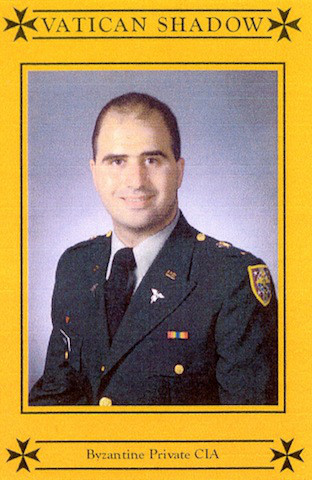
‘Byzantine Private CIA’, Vatican Shadow’s debut tape, could be one of the project’s most interesting releases when observed from today’s revisionist ears and eyes. The sound of the ‘CIA’ unmistakably plays on Fernow’s experimental background, resulting in mixture of a psychedelic Post-Industrial and corroded Techno. ‘Cairo Sword Unsheathed’ and ‘Gunmen With Silencer’ surely sound like Vatican’s signature work which will define the project over the years to come, but disfigured dub-psych of ‘Deny Military Involvement’ could easily be a product of an early Rainforest Spiritual Enslavement sessions while rhythmic terror of ‘Archbishop 911’ has fragments which sound like some Prurient’s Pleasure Ground material buried deep beneath the sand.
Physical format:
– Cassette (100 copies – 2010, Hospital)
Can be found on Byzantine Private CIA (Vinyl – 500 copies – Yellow, Black – 2019, Hospital)
Kneel Before Religious Icons (2011)
![]()
“CAN CHRIST THE MESSIAH BE BOTH DAVID’S LORD AND DAVID’S SON?”
Despite the progression that Vatican Shadow, as a project, had over the years (in all aspects), it seems like the media and critics keep hanging on to the same descriptions and PR from the Vatican’s early days. Well, the PTSD-inducing forty minutes of ‘Kneel Before Religious Icons’ could be a holy grail of that *militant religious industrial* direction, not only because of the paranoid presentation through artworks newspaper-clipping track titles such as ‘Shooter in the Same Uniform as the Soldiers’, ‘Chopper Crash Marines’ Names Released’ or ‘Worshippers at the Same Mosque’, but more importantly due to sound. It continues off the martial tape techno initiated on ‘Byzantine Private CIA’ second half and stretches it over eight tracks of nervous lo-fi Industrial which loop on and on until they abruptly end – maybe the tape ran out, maybe the chopper got hit, no one knows for sure. Over time, Fernow surpassed the technique presented here but, to this day, ‘Kneel Before Religious Icons’ remains an axiom of modern industrial music, an undeniable treat of a noise-inflicted wardance.
Physical format:
– Cassette (33 copies – 2011, Hospital)
– Vinyl (has different artwork – Clear Green, Black – 2012, Type | 250 copies – Gold, 300 copies – Black – 2019, Hospital)
Pakistan Military Academy (2011)
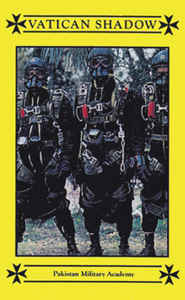
“BY FAITH THE WALLS OF JERICHO FELL DOWN AFTER THEY HAD BEEN ENCIRCLED FOR SEVEN DAYS. THE LORD PROMISED THEM VICTORY OVER THE WHOLE OF THE LAND.”
“FOR WE HAVE HEARD HOW THE LORD DRIED UP THE WATER AND THE SEA.”
Talking about the *martial religious industrial*, ‘Pakistan Military Academy’, often perceived as Vatican Shadow’s finest hour, comes off as a stellar companion piece to ‘Kneel Before Religious Icons’. They both utilize the ‘full’ forty minutes but ‘Pakistan’ only allowed four tracks to come inside, letting the tension build off its repetitiveness even further and thus showing some early glimpses of how atmospheric and hypnotic the music of Vatican Shadow can be while given enough space. While ‘Icons’ almost exclusively played on the tape-techno card, ‘Academy’ explores different realms of experimental electronic music palette, steering between Ambient, Techno and (downtempo-) looped Industrial, making you unsure whether it’s suspiciously meditative or a proper pre-meltdown moment that makes you close your windows and turn the lights off…
Physical format:
– Limited cassette run (125 copies – 2011, Hospital)
– Vinyl (200 copies – Orange, Black – 2019, Hospital)
Mural of Saddam (2011) [EP]
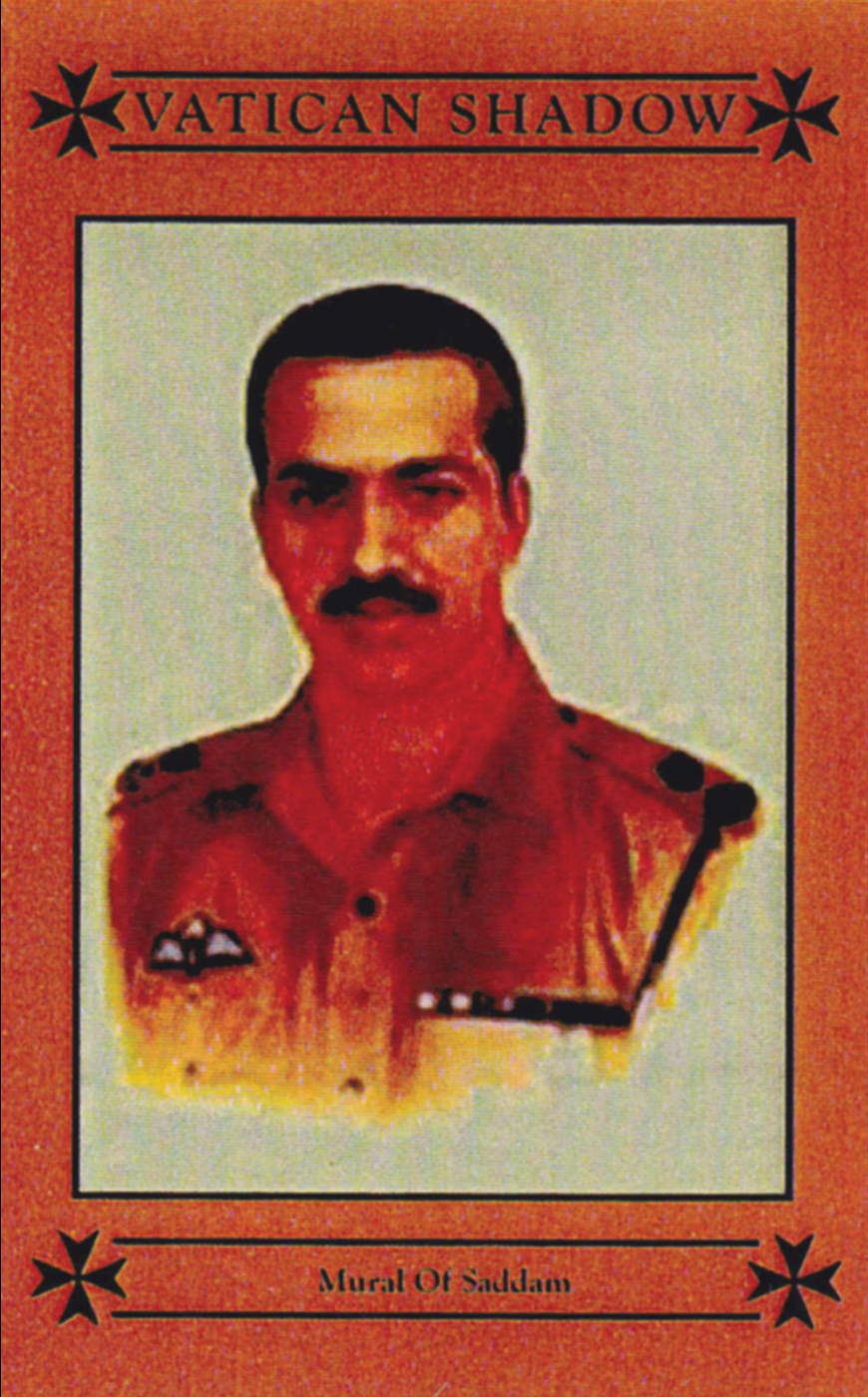
‘Mural of Saddam’ is one of the tapes that gets treated a bit *unfairly* in the retroactive context, not only had it never got the stand-alone reissue treatment under its name, but the song themselves tend to be forgotten. The tape starts with a massive soundsystem killer ‘Schwarzkopf Arc of Triumph’ but the real treasure are the songs which follow: ‘Saddam Statue Conspiracy’ and ‘U.S. M1A1 Abrams Exhaust Rises Between The Hands Of Victory’, criminally overlooked excursions into Muslimgauze-style Ambient Dub. They both clock just little over five minutes (together), and that may be the main reason why Saddam hasn’t reached the atmospheric heights of ‘Pakistan Military Academy’ (compared primarily because of that being an available reference at that point in time). Luckily, the best was yet to come…
Physical format:
– Cassette (125 copies, 2011, Hospital)
Can be found on Byzantine Private CIA (Vinyl – 500 copies – Yellow, Black – 2019, Hospital)
Washington Buries Al Qaeda Leader at Sea – Deck One (2011) [EP]
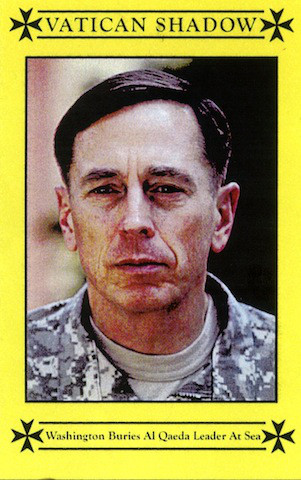
‘Washington Buries Al Qaeda Leader at Sea’ trilogy starts with noise-stained flirtations of mournful Industrial and broken Ambient Techno presented on Deck 1. Just like any part of the series, it has its own head and tail and can exist on its own, but works the best when observed as an intro to the decks which will follow.
Physical format:
– Cassette (2011, Hospital)
Can be found on Washington Buries Al Qaeda Leader at Sea (300 copies – Transparent Blue, 500 copies – Black – Hospital, 2019)
Washington Buries Al Qaeda Leader at Sea – Deck Two (2011) [EP]
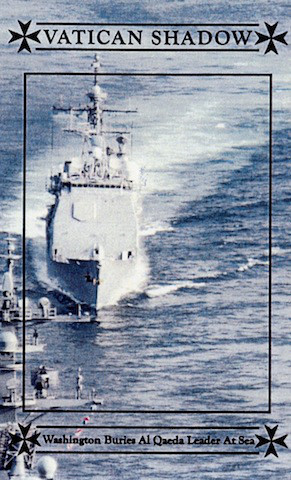
“ALL THE VESSELS OF BRASS AND IRON ARE HOLY AND WILL BE PUT IN THE TREASURY OF THE LORD.”
The second instalment in the Washington trilogy brought even more of the duality presented on the first Deck. ‘Bin Laden’s Corpse’, despite the gloom-transmitting from its title, is one of the Vatican Shadow’s more optimistic songs, fluttering on the suspiciously meditative Dub. Soon after, the peace proves to be illusory because ‘USS Carl Vinson Night Tide Funeral’ returns in the suspenseful combat mode. The side B is also special because it sounds like a live show excerpt – where most of the Vatican Shadow music until that point consisted solely of loops, this time there were different layers organically appearing and disappearing throughout the track, raising a whole new anxiety through its unpredictability.
Physical format:
– Cassette (2011, Hospital)
Can be found on Washington Buries Al Qaeda Leader at Sea (300 copies – Transparent Blue, 500 copies – Black – Hospital, 2019)
Washington Buries Al Qaeda Leader at Sea – Deck Three (2011) [EP]
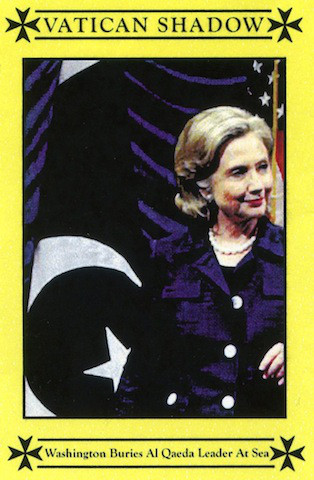
Washington’s third ‘Deck’ just radiates with tension. In the same way Prurient may assault your senses with his abrasive approach, Vatican Shadow does it in a passive and sublime manner. Despite most of his work having some sort of cinematic values, this third, and final, part of the trilogy takes that to the new heights with its double-punch involving Middle East arms-market montage Dub of ‘Supplying The Compound With Food And Medicine…’ and funereal Ambient scenery of ‘Peace Be Unto You’, closing the *burial* in a near spiritual manner. If there ever was a tape which sounds like it could repeat forever, the meditative transmissions from Deck 3 are sure to be among the few chosen ones…
Physical format:
– Cassette (2011, Hospital)
Can be found on Washington Buries Al Qaeda Leader at Sea (300 copies – Transparent Blue, 500 copies – Black – Hospital, 2019)
Yemeni Commandos (2011) [EP]
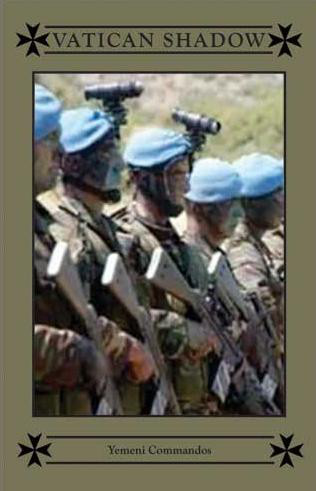
“STONES OF THE OUTER WALL HAD FALLEN OUTWARDS, APPEARING TO CRACK FROM AN EXTRANEOUS FORCE.”
Similarly to ‘Mural of Saddam’, ‘Yemeni Commandos’ gets lost in the *early tapes* drawer of Vatican Shadow’s discography, suffering from lack of the stand-alone reissues which is (once again) a byproduct of its short length. ‘Yemeni Commandos’ cassette was released on the mysterious Sans Issue, not on Hospital – as it’s usually assumed, making it the first Vatican Shadow release outside of the home turf. Of course, if you dig deeper, you will notice that Sans Issue almost exclusively involves Hospital’s co-conspirators so that isn’t much big of a deal after all. Once all this archivist information is cleared, lets move on to what truly is a big deal, and that is ‘Asymetric Warfare Studies Group Double Game’, whose ice-cold synths not only summon some of the best night-vision Techno that Vatican Shadow ever made, but also show why people had a hard time understanding the difference between Vatican Shadow and Prurient’s ‘Through the Window’ – a duality which eventually led to Prurient becoming a ‘beatless’ project.
Physical format:
– Cassette (2011, Sans Issue)
Can be found on Byzantine Private CIA (Vinyl – 500 copies – Yellow, Black – 2019, Hospital)
The Serpent Carries Him Back Into Paradise (2011) [EP] {Vatican Shadow / Contrepoison}
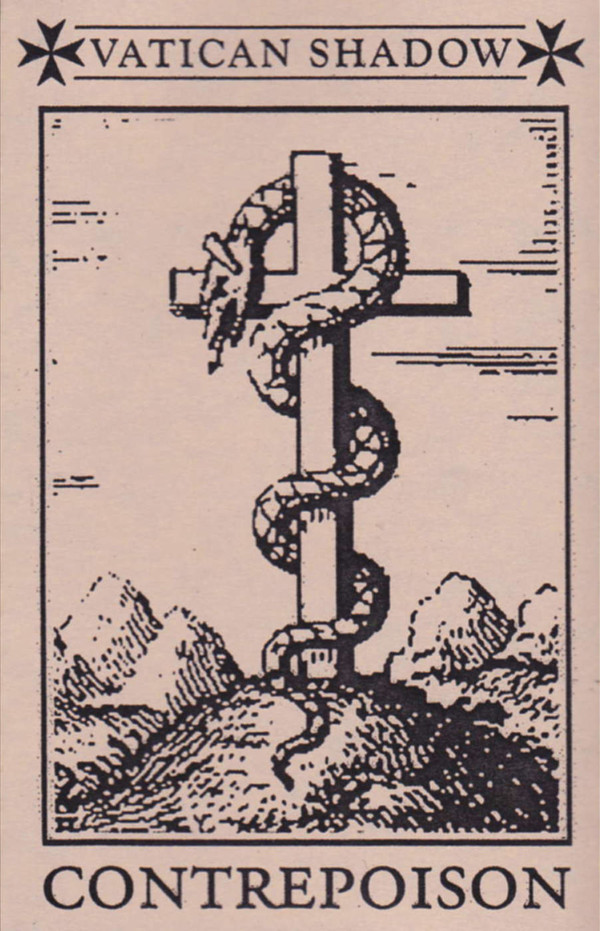
Vatican Shadow’s first collaborative record happened to be with Contrepoison, a fuzzy Coldwave project by Fernow’s usual co-conspirator Akitsa. Probably due to lack of war on terror imagery, ‘The Serpent Carries Him Back Into Paradise’ mostly flew under the radar, despite containing one of the Vatican’s early gems – spiritual Death Dub ‘Unknown to the Peacock the Serpent and Scorpion Conspire’ which felt like Vatican Shadow reimagining a Rainforest Spiritual Enslavement track.
Physical format:
– Cassette (2011, Hospital)
Vatican Shadow’s songs can be found on Kuwaiti Airforce (Vinyl – 300 copies – Blood Red, 500 copies – Black – 2019, Hospital)
PHASE TWO:
TRIUMPH OF RELIGION (2012)
The second phase of Vatican Shadow’s discography is an unhumanly-productive year of 2012 – not only for Vatican Shadow but other Fernow’s projects as well. During the year, Vatican Shadow definitely proved itself as a project to stay around – critically and audience-wise, if abandoning Cold Cave already wasn’t a signal enough from Dominick’s side. In 2012, Vatican Shadow expanded its sound to the new terrains of unclassifiable Techno, releasing some of his most-cherished and sought-after classic works, but also expanded to the ‘foreign’ turf by (re-)releasing records on Blackest Ever Black, Modern Love and Type – some of the key labels in the leftfield electronic music at the time, as well as publishing two ‘zines ‘A Lie Must Tell A Single Story’ and ‘Here Is Why The Story Falls Apart’. Finally, Fernow made the Vatican Shadow live debut with ‘uncompromising six tape setup’ playing Los Angeles, London (on Blackest Ever Black night) and Berghain (on Downwards night).
Iraqi Praetorian Guard (2012) [EP]
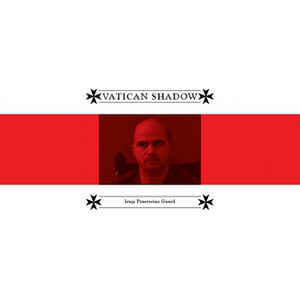
“HE SAW THE RED LASER SIGHT FLASH ACROSS HIS FACE. HE CLOSED HIS EYES AND FELT THE BULLET HIT HIS HEAD, JUST ABOVE HIS LEFT EYE. HE FELL TO THE FLOOR. OUT OF HIS RIGHT EYE, HE COULD SEE A SOLDIER DRESSED IN CAMOUFLAGE FATIGUES TARGETING OTHER SOLDIERS.”
The golden age of Blackest Ever Black’s, or Kiran Sande’s if you like, curatiorial genius was mostly evident through digging the impossible-to-find obscurities from mutated Post-Punk variations or cult electronics. When it wasn’t retroactive, it was about giving platform to artists whose creativity managed to go beyond the predictability of industry’s (or internet’s) established patterns. Taking that into consideration, there’s no surprise in Blackest Ever Black having a Vatican Shadow record out this early in his career. ‘Iraqi Preatorian Guard’ EP contains two of the *militant religious industrial* tracks from ‘Byzantine Private CIA’ paired with Regis’ graveyard shift remix of one of the ‘Kneel Before Religious Icons’ rhythmic highlights – ‘Church Of All Images’. A fine document of history, having Blackest Ever Black, Regis and Dominick Fernow at the same record in a crucial time for modern electronic music.
Physical format:
– Vinyl (two runs with different sleeves, 2012, Blackest Ever Black)
Operation Neptune Spear (2012) [EP]

Someone on YouTube, while referring to the Vatican Shadow’s newfound ‘household fame’ and clean sound, commented something about missing the days when Dominick didn’t know how to make Techno yet. Perhaps, no other release evokes that nostalgia better than ‘Operation Neptune Spear’, a razed-to-the-ground rehearsals for his first live performance in Los Angeles (with Demdike Stare and Tropic Of Cancer). What makes this tape so special is the fact that there’s nothing that sounds like it – an intoxicated diary writings or tape recordings being randomly overdubbed in a manic manner, with disregard to its overall contents. ‘Operation Neptune Spear’ is a historic document foremost, not because of the Vatican Shadow’s songs that appear here but primarily because of the moments where they don’t appear at all and he uses the surreal collaging of Techno, Middle Eastern vocal samples and white noise, basically playing the Prurient card just to fight the nervousness, or ‘impostor syndrome’, off. Insane…
Physical format:
– Cassette (17 copies available at the show – 2012, Hospital)
Can be found on Ornamented Walls Vinyl (Transparent, Black, Orange – 2012, Modern Love)
September Cell (2012) [EP]
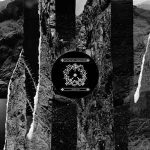
Contrary to the airstrike chaos of the tapes that encircled it – the butchered Noise-Techno collages of Kuwaiti Airforce and Operation Neptune Spear – something different had been prepared for the launch of Bed of Nails, a new label marked by Fernow’s relocation to Los Angeles and focused on “industrial dancefloor rhythms and seductively isolated electronics”. There goes Vatican Shadow’s “September Cell” – not only that neither of its earlier records sounded so clean and polished to that point, but it also had some unusually ‘standard’ ‘song’ formatting. The EP was / is a pure atmospheric Ambient Techno brilliance, flirting with occasional breakbeats and nervous meditations, even pervertedly channeling the vintage Aphex Twin vibes in an all time classic ‘Cairo Is A Haunted City’.
Physical format:
– Cassette (150 copies – 2012, Bed Of Nails)
– Vinyl (Blue, Black – 2012, Bed Of Nails)
Jordanian Descent (2012) [EP]
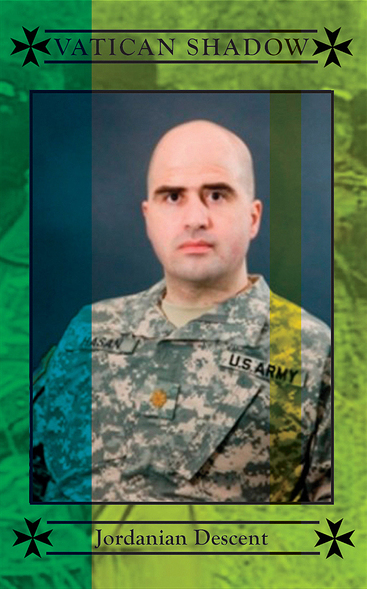
“PETER WAS SLEEPING BETWEEN TWO SOLDIERS, LOCKED UP WITH TWO CHAINS.”
Earlier, we already witnessed how atmospheric can Vatican Shadow’ music be when given enough time and space, mostly clocking around ten minutes – now imagine it taking ten more because that’s exactly what happened on ‘Jordanian Descent’, the first instalment of Vatican Shadow’s *holy trinity* from the Fall of 2012. A trinity which will later be released together as ‘It Stands To Conceal’ compilation. ‘Jordanian Descent’ is a brutal drill in Godflesh-heavy electronics, covering the grey area between screwed Industrial Techno and intense militant Dub, not using time to build but rather to alter your mind with its trance-inducing repetition. There’s a thin line between sounds being perceived as ritual, tribal and martial – ‘Jordanian Descent’ may be a point where that line blurs completely.
Physical format:
– Cassette (150 copies – 2012, Hospital)
Can be found on It Stands to Conceal Vinyl (119 copies – 2012, Hospital)
Atta’s Apartment Slated For Demolition (2012)
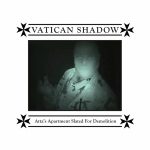
“WHEN THE TOWER OF JERICHO WAS BUILT, MOUNTAINS CAST A SHADOW ON IT AS THE SUN SET. THE SHADOW FELL EXACTLY ON THE STRUCTURE, THEN SPREAD OUT TO COVER THE ENTIRE VILLAGE.”
Just like the album’s artwork suggests, ‘Atta’s Apartment Slated for Demolition’ is a definite midnight-Techno statement – a homogenous mixture of stealth IDM meditations ready to soundtrack some sleep-deprived hours of incognito web-browsing, starring into WikiLeaks articles and playing Splinter Cell while downloading random files off dark web. Why all this analogies? Because I tried to portray an inverse effect of what seems to be the ‘background music’. In the usual circumstances, the music would just be a backdrop for your activities – in case of ‘Atta’, there is a seductive factor which not only makes you feel like a part of the process, but eventually encourages your own activities, making you feel like a target of a conspiracy. Possibly the Vatican Shadow’s most subtle record and yet the most effective one in a mental way. A definitive introvert-Techno pinnacle.
Physical format:
– Cassette (75 copies – 2012, Hospital)
Can be found on It Stands to Conceal Vinyl (119 copies – 2012, Hospital)
Ghosts of Chechnya (2012)
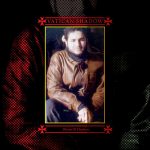
While ‘Jordanian Descent’ and ‘Atta’s Apartment Slated For Demolition’ both had a pretty clear and homogenous sonic direction, ‘Ghosts Of Chechnya’ is a record whose unpredictability captures heaven and hell simultaneously – like an asymmetric warfare channeled through music, making it one of the absolute favorites in fan circles. The tape opens with ‘Encryption Nets’ which feels like a natural successor of ‘Atta’ and thus makes you safe; suddenly, it flows into mechanical flesh-Dub ‘The House Of The Followers’ just to get hit by the airstrike electronics of ‘Peace Rage’. It seems like the storm is over once Terminatoresque industrial march ‘The Hamburg Cell Was Born In Chechnya’ starts, but not for long because the combat ignites again, this time on land. The restlessness continues until the closer ‘Snipers As A Breed Tend To Be Superstitious’, an all-time highlight in isolationist electronic meditations. I praised Vatican Shadow’s music for being hypnotic amongst other things, mostly correlating it to track lengths; ‘Ghosts‘ proves us that he can evoke the same feelings of dread and helplessness even when the record is heterogenous and style-shifting gets you of the comfort zone. Again, it sets the mood rather than comforting your own one.
Physical format:
– Cassette (97 copies – 2012, Hospital)
Can be found on It Stands to Conceal Vinyl (119 copies – 2012, Hospital)
Kuwaiti Airforce (2012) [EP]

If someone went through the whole Vatican Shadow’s opus but did it quickly, without letting the music sink in properly, there’s a strong chance that ‘Kuwaiti Airforce’, together with ‘Operation Neptune Strike’, would be the easiest one to differentiate from others at this point in the discography. They are both live recordings (this one was only available at the September 29, 2012 show in Los Angeles with Silent Servant, Demdike Stare, Andy Stott and Kangding Ray) and it’s easy to distinct them as improvised experiments (or a Noise albums) rather than DJ sets. Also, they both mercilessly butchers the songs with some ear-shattering white noise. With that said, it’s impossible to ignore the shades of Prurient here and thus that makes it a very special moment in time, when both projects were basically interchangeable and complementary. You could even call ‘Kuwaiti Airforce’ as *Vatican Shadow remixed by Prurient*, or imagine a Hospital sticker hyping it as a *militant religious industrial getting a Doom Electronics treatment*, with PR mentioning *a desolate airforce landing spot*. A match made in (noise) heaven I guess…
Physical format:
– Cassette (25 copies available at the show – 2011, Hospital)
Can be found on on Kuwaiti Airforce (Vinyl – 300 copies – Blood Red, 500 copies – Black – 2019, Hospital)
Ornamented Walls (2012)

Just like in case of Blackest Ever Black’s ‘Iraqi Praetorian Guard’, on Ornamented Walls (released on Modern Love) Vatican Shadow didn’t use the external label card to release some new music but rather to re-release the one you may have missed, as well as to add some reworks of it. The side A contains the impeccable live rehearsals already released in the form of Operation Neptune Spear, giving a vinyl treatment to a fine historical and sonic document of Vatican Shadow’s early pre-Techno live shows, (un)safely played through Prurient’s noise assaults and trance-inducing vocal samples. Still, as this record often gets dismissed, it would be a crime to omit the side B which flows off the Spear’s experimental agenda, this time in a studio environment. The intoxicating religious delirium of ‘Nightforce Scopes’, noise-disfigured ‘Yemeni Telephone Number’ and ritualistic creeper ‘India Has Just Tested A Nuclear Device’ all channel the sounds heard on live rehearsals, potentially even being the layers to it. Fernow focused on deconstructing songs rather than building them up, which led to remixing and defacing some of his own most accessible tracks such as ‘Cairo Is A Haunted City’ or ‘Church Of All Images’ – taking all the likability out of them, stripping them to the skeletal form and, ironically enough, arming them for a whole new type of combat.
Physical format:
– Vinyl (Transparent, Black, Orange – 2012, Modern Love)
PHASE THREE:
CONSPIRATORIAL WHISPERS (2013-2014)
The third phase of Vatican Shadow’s discography is a bit quieter, building off the foundation laid during the earlier phases, strategically moving figures over the board game – releasing his ‘first proper album’ and expanding his sound even further into the black hole of underground dancefloors. This phase is the exact moment where Vatican Shadow got slightly more ‘premium’ (?!) feeling and set the final tone for the things to come – both ‘commercially’ and sound-wise. When arguing the meaning of an album, Fernow said:
“I usually self-release. And I put what I do into two categories: research and albums. And while the definition of an album is a loose one, and in some cases a literal one based on time duration or formatting, I define the albums as the less-specific combination of the results of the research of the individual releases that I have put out myself, which always deal in specific sounds and subjects. If you’re trying to emphasize the conclusion of the research, a third party is needed in essence to publish the result of that research. Even if you look at it in an academic way. Formatting is important.” (Creative Independent, 2018)
Remember Your Black Day (2013)

“I’M NOT NAIVE AND I DON’T ROMANTICIZE WAR, THE WORST MOMENTS OF MY LIFE HAVE COME AS A SEAL, BUT I CAN STAND BEFORE GOD WITH A CLEAR CONSCIENCE.”
“Remember Your Black Day“ was promoted as Vatican Shadow’s ‘first proper album’. Since he was already more than 15 releases deep as Vatican Shadow, Fernow explained the logic as the albums are “less-specific combination of the results of the research of the individual releases, which always deal in specific sounds and subjects” – in other words, ‘Black Day’ was supposed to be the ultimate presentation of the Vatican’s main strengths and not only did it achieve that but there was also some new growth and progression. ‘Tonight Saddam Walks Amidst Ruins’, ‘Muscle Hijacker Tribal Affiliation’ and ‘Jet Fumes Over The Reflecting Pool’ all feel like a new take on 2012’s impeccable run of paranoia-summoning midnight-Techno Dub. ‘Enter Paradise’ is a disfigured Black Metal distortedly playing out of the melted walkman in a razed building. Finally, the jet-black underground Techno of ‘Contractor Corpses Hung Over The Euphrates River’, ‘Remember Your Black Day’ and ‘Not The Son Of Desert Storm, But The Child Of Chechnya’ brought the first absolute dancefloor rhythms to Vatican’s catalog. I don’t necessarily focus on other reviews or critical acclaim here, but I’m certainly surprised by Pitchfork’s take on this album, insisting how it “repeatedly suggests something that it never becomes: dangerous“, adding how “all this war iconography begins to feel like false provocation” and finally saying how it “didn’t quite nail his gift for making cohesion out of disunity“. I must strongly disagree because for one: isn’t ‘false provocation’ or ‘a tease’ one of the most important aspects of the Vatican Shadow’s project? Expecting ‘answers’ means missing the point because it’s about raising questions first. For two, I feel like ‘Remember Your Black Day’ flows impeccably, leaving an impression of a linear narrative, rather than shuffling the cards and taking the surprise airstrikes.
Physical format:
– CD (2013, Hospital)
– Vinyl (Blue, Black – 2013, Hospital)
When You Are Crawling (2013) [EP]

“AND YOU, BY ALL MEANS ABSTAIN FROM THE ACCURSED THINGS, LEST YOU BECOME ACCURSED.”
“THE COVENANT IS BREAKING BETWEEN THE INTELLIGENCE OFFICERS HANGING AT THE POINTY END OF THE SPEAR, AND THE GOVERNMENT THAT AUTHORIZED THEM THERE.”
‘When You Are Crawling’ is a bonus disc designed to accompany ‘Remember Your Black Day’ and develop its leanings towards brute, caustic and head-stomping dancefloor rhythms even further, all with a little help from Sandwell District’s Silent Servant. A sentence later, I sort of regret labelling it as a *bonus disc* since that automatically generates some lesser connotations which isn’t deserving here. ‘When You Are Crawling’ is an absolute behemoth, especially its center-piece – a thunderous, fifteen minutes long ‘Atta’s Apartment Slated For Demolition (Bouthayna Engineering)’, which unmistakably cemented Vatican Shadow as the serious Techno project, competent to shatter any underground club down to pieces.
Physical format:
– CD (2013, Hospital)
– Vinyl (Jade, Black – 2013, Hospital)
Death Is Unity With God (2014) [Compilation]

“IN THE RUINS OF A MUD BRICK WALL TRAVELLERS FROM GALILEE WERE FOUND.”
* Consists of six EPs (in their entirety) which would get an individual digital release two months later (‘April Silencer’, ‘Easing of Our Task’, ‘Elohim City’, ‘Enduring Mysteries’, ‘Fireball’, ‘Oklahoma Military Academy’).
* Unlike ‘Washington Buries Al Qaeda Leader At Sea’, where I decided to list Decks individually due to them being released as a stand-alone cassettes, I’m featuring ‘Death Is Unity With God’ as a whole. Despite this ‘compilation’ being conceived out of the six EPs, those EPs were never released individually in a physical way, their artworks were meant to connect and, as the years went by, no one ever refers to any of them individually; it’s always ‘Death Is Unity With God’.
‘Death Is Unity With God’ is a massive two and a half hour project, stepping away from the polished direction of ‘Remember Your Black Day’ back into the bunker-based warfare of Vatican Shadow’s earlier cassette work but also, once again, exploring new fields of claustrophobic electronic music. If there were Vatican Shadow records which could soundtrack a film, ‘Unity’ is certainly the one which could soundtrack a video game due to its wide palette of discomforting but relatively distant sounds, mostly centered around the Waco Siege and Branch Davidians. Starting with twenty-six minutes of suffocating drone-infused field recordings ‘Al Qaeda (Branch Davidian)’, the album develops into a plethora of sounds which Vatican Shadow is admired for, such as nightcrawling Industrial of ‘FBI God’, paramilitary death-stepper ‘It’s To Come’, deconstructed dancefloor gear of ‘Koresh Lamb’, ‘Koresh Babylon’, ‘Texarkana Resistance’ and finally a witching-hour stealth Techno of ‘Waco Postmortem (Murrah)’ which could be an AFX track distorted and bootlegged on the black market. ‘Death Is Unity With God’ can be a hard to process for some, possibly being Vatican’s most inapproachable record, but it is a much needed detox of ‘When You Are Crawling’ brilliance, possibly having its ‘simple’ track titles as its biggest flaw.
Physical format:
– Cassette (100 copies – 2014, Hospital)
– CD (2014, Modern Love)
– Vinyl (200 copies – Green + Transparent Yellow, Black – 2014, Modern Love)
* Cassette and CD releases contain 19 tracks / songs – six EPs in their entirety, Vinyl version has 12 tracks (13 songs)
Games Have Rules (2014) {Function & Vatican Shadow}
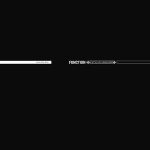
After being remixed by Regis (and invited to play Downwards’ night in Berghain), produced by Silent Servant, Vatican Shadow got the third Sandwell District co-sign by collaborating with Function on a full LP. ‘Games Have Rules’, depending on what you seek with it, profits as a professionally made record holding to high production standards of Sandwell-affiliated Ambient and Techno music, channeling the bleepy nature of 1990s ‘intelligent’ electronics, but eventually suffers from the unpredictability and danger that we’re used to get through Vatican Shadow solo releases. The cover is minimalistic, the track titles are ‘safe’, as well as their sound so, due to overall *premium* impression it gets interesting to find out that this got released through DIY-first Hospital Productions rather than Ostgut. I think you, I or whoever would appreciate this record a lot more out of the context of a Vatican Shadow list. It seems like a project which, when focusing on all the non-music information, should be the *best of both worlds* but weirdly limits the both acts. Still, who would have thought that there would be a Vatican Shadow record labelled as *soothing*.
Physical format:
– CD (2014, Hospital)
– Vinyl (Clear, Black – 2014, Hospital)
PHASE FOUR:
WEAPONS INSPECTION (2015-2018)
In 2016, Fernow signed with Berghain’s Ostgut management for his Vatican Shadow and Prurient projects and, naturally, that led to even more ‘professionalism’ in its approach to conceiving records, (Note: I am not saying something from the earlier phases wasn’t ‘professional’, just highlighting the difference in presentation), mainly manifested through artwork / packaging and production standards.
In a review of his Ostgut debut, Pitchfork observed:
“Here, Fernow is figuring out how to mold Vatican Shadow to his newfound success, while maintaining a mysterious air. It heightens the contradiction that has always driven Vatican Shadow: while it’s Fernow’s most accessible project, it’s shrouded by an oblique presentation. Before, it was vague references to terrorism abroad and the shadowy nature of modern politics; now, it’s a darker overall sound that’s more within reach, but also more impenetrable. Floodwaters looks like the start of a new era, and it’s not as though Vatican Shadow wasn’t danceable.”
Fernow himself noted the difference:
“I worked with Josh Eustis (Telefon Tel Aviv) in Los Angeles as a producer for Rubbish of the Floodwaters. The concept was to bring together the early hand held tape recording manipulation, the obsessive midi processing and the more recent club oriented live sets. Josh was the only one that could bring all those disparate elements together and had the reference points that would fit into the Ostgut Ton canon. As a collector of the label, it was a steep challenge to meet their standards, but working closely with the team it revealed to me why i always felt drawn to the label. Every decision, detail and choice from presentation to concept is considered at Ostgut Ton, which made it a perfect match internally despite the different worlds we come from. The interpretation and inspiration is for the audience to decide, whether their conclusions are informed or not.” (Style Zeitgeist, 2017)
In the same interview, he added:
“The best club tracks do nothing but sound like everything and rush everywhere in the space in front of you. When working with Josh we had to find the balance between functionality and the decaying atmosphere of belief/non-belief that the subject deals with. We arrived at a terminology of ‘economy of means’ and ‘trading’ in terms of percussion rather than my traditional impulse to constantly add and build drums. The contradictory magic of restraint and decadence is the techno we strive for.”
Media In The Service Of Terror (2016)
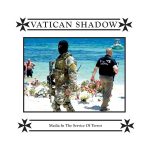
“YOU SHOULD DO AS YOU DID TO JERICHO. THERE ARE NO STONES LEFT IN THE VALLEY OF ACHOR.”
“FOR WHOEVER HAS WILL BE GIVEN MORE, BUT WHOEVER DOES NOT HAVE, EVEN WHAT HE HAS WILL BE TAKEN AWAY FROM HIM.”
The architecture and sound design of ‘Media In The Service of Terror’ further proves that ‘Death Is Unity With God’ feels like an outlier in Vatican Shadow’s post-2012 opus, and while one could even find some correlation with Function collaboration in sense of a relatively clean production, it mostly resembles the package of ‘Remember Your Black Day’ and ‘When You Are Crawling’. Similarly to ‘Remember‘, it has the *album* aura, steering between the masterful conspiratorial ambience (‘Ziad Jarrah Studied Mathematics’, ‘Interrogation Mosaic’), nausea-inducing Industrial psychosomatics (‘Take Vows’) and club rattlers (‘More of The Same’), closing it with two remixes (leading to its parallel with ‘When You Are Crawling’). ‘Media In The Service Of Terror’ didn’t bring anything new to Vatican Shadow discography, especially if you consider that almost two years had passed since the last release, but it proved to be a much-necessary record which set the tone for things to come by showcasing its unmatched brilliance while basically being a genre-of-its-own.
“FOR WHOEVER HAS WILL BE GIVEN MORE, BUT WHOEVER DOES NOT HAVE, EVEN WHAT HE HAS WILL BE TAKEN AWAY FROM HIM.”
Physical format:
– Cassette (125 copies – Boxset, 175 copies – Regular – 2016, Hospital)
– Vinyl (Aqua Blue, Black – 2016, Hospital)
Rubbish Of The Floodwaters (2017) [EP]
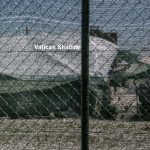
“SOME RESURRECT THEMSELVES AFTER NEAR-DEATH EXPERIENCES IN POLITICS, WHILE OTHERS CONTINUE TO APPEAR POLITICALLY ALIVE EVEN WHEN THEY HAVE ACTUALLY DIED.”
‘Games Have Rules’ brought the flawless production values but, due to collaborative nature of a project, didn’t truly click as a Vatican Shadow project as a whole. ‘Rubbish Of The Floodwaters’, his Ostgut Ton debut, showed what happens when you connect authentic Vatican approach with such premium production standards. Unlike the rusty tape-Techno of his earlier work, or even the later ‘polished’ work, ‘Floodwaters’ is almost ethereal due to its pillow-soft drums and bass, starting with signature mournful prayer ‘They Deserve Death’ but most evident in unmistakably-Berghain title track and ‘Weapons Inspection’, both flying in the near-hallucinogenic interzone of Minimal and Ambient Techno. ‘Floodwaters‘ is a textbook example of *selling out* by growth and on your own terms, never compromising what made you great in the first place but enriching it in order to avoid stagnancy and predictability.
Physical format:
– Vinyl (2017, Ostgut)
Luxor Necropolitics (2017)
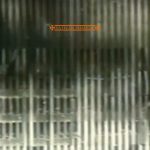
“THE UNTRANSLATED WRITINGS DESCRIBED THE BLIND SHEIKH’S SERMONS WHICH SAID THAT THEY WANTED TO HIT THE EDIFICES OF CAPITALISM – THE HIGH WORLD BUILDINGS. THUS THE LUXOR TEMPLE WAS A SHRINE OF THE KING’S CULT AND NOT JUST TO THE MONOTHEIST VICTORIES OVER THE SEA PEOPLES.”
‘Luxor Necropolitics’, despite being ‘recorded in Los Angeles in 2016’ and released on Hospital, feels like a Berlin-born record, or at least a second Ostgut Ton release – a natural continuation of ‘Rubbish Of The Floodwaters’, both products of Josh Eustis’ productions. In many ways, ‘Luxor‘ felt like a final stage in Vatican’s evolution from a paranoid *basement* project to a *serious* Techno force, delivering killer rave cuts such as ‘Egyptian Journalist Syndicate’ without breaking a sweat, but also recontextualizing some of his signature cinematic work through the title track, which is a Eustis’ treatment away from being undercover on ‘Atta’s Apartment Slated For Demolition’. Also, there is a Female remix of ‘More Of The Same’, one of the Vatican’s most fan-favorite live tracks, thus closing the circle on Sandwell District’s treatment of his music.
Physical format:
– 10″ Vinyl (250 copies – Red, 500 copies – Black – 2017, Hospital)
Bunkerterror (2017) [EP] {Vatican Shadow & Ancient Methods}
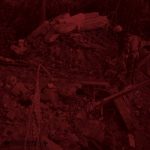
Ancient Methods and Vatican Shadow are infamous for their mind-shattering live sets which utilize the Ugandan Methods approach with Fernow screaming his soul out over the fierce, Methods-driven, Technoid destruction. ‘Bunkerterror‘ is a floorsweeper, as you may have expected, with each act delivering an absolute stomper to their New York and Berlin sides respectively. Possibly, the heaviest record on this list.
Physical format:
– Vinyl (Gold, Black – 2017, Hospital)
PHASE FIVE:
FORT HOOD AGAIN (2019-)
Many in 2019, including me, thought that Vatican Shadow as *militant religious industrial* is a thing of past and now functioning exclusively as a ‘real’ techno project. We were definitely wrong since this (ongoing) era brought the project back to its basics without abandoning its new tricks – a move that could be connected to his return to New York. The spring of 2019 marked the release of Berghain 09 through, a V/A compilation of exclusive songs and a *full* mixed version on Soundcloud. The beautiful thing about the mix is that it isn’t a regular ‘sequence of songs’ that professional DJs usually do, this one is a rhapsody of ideas and sounds, simultaneously sounding like a moodboard and a chaotic stream-of-thought; despite having a full track listing, no one can ever replicate it in the exact same way considering that snippets of so many songs constantly play simultaneously; it’s just one more instance where Fernow used the back door to his own benefit. When I observe it from 2021 eyes, when we’re a year deep into lockdown, that mix sounds like a swan song to the clubbing days, not only to us but to the project as well.
*Note: since this era is still ongoing, I didn’t make any ‘conclusions’ – will edit it in the future.
Opium Crop Airstrikes (2019) [EP]

“WITH THE STAFF THAT IS IN MY HAND I WILL STRIKE THE WATER OF NILE, AND CHANGE IT TO BLOOD.”
Even though Vatican Shadow’s complete shift to *Techno*, at least in its Berlin definition, had been done impeccably, there was a danger to fall into redundancy with it. A danger that had been successfully avoided by ‘Opium Crop Airstrikes’, a late killer coming out of nowhere, as airstrikes usually do. The tape opens with ‘Opium Crop Airstrikes’, a fifteen minute monolith covering the grey area between ‘Jordanian Descent’ Tribal Industrial, Muslimgauze’s unclassifiable Dub and DJ Screw’s tape treatment, then flows into signature tactical nightscope-stepper of ‘Hellfire Hidden Tribes’ before finally closing the funeral with glitchy collage ‘Loyal To The Deceased’. ‘Opium‘ is a masterful work which does so much with so little, reaching the atmospheric heights of Fernow’s best work (under any alias) in less than thirty minutes.
Physical format:
– Cassette (Kickstarter-only + some leftover copies – 2019, Hospital)
– Vinyl (500 Copies – Black, 300 Copies – Purple – 2020, Hospital)
Church Of All Hallows’ Eve (2019)
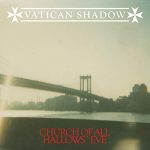
A Halloween special, released at the same time as Prurient’s ‘Noise For Halloween Night’ for none other than Amazon Music, leaving it as one of the rare Vatican projects which never got the physical treatment. It’s hard to tell how much intentional humour is actually there, considering the nature of a release and track titles which mash-up the Vatican’s original work and ’80s B-Horror (‘Exorcism Training Course’, ‘Loyal To The Evil’, ‘Deliverance from Posession’) but the music was mostly brilliant nonetheless. ‘Cairo Is A Haunted City’, ‘Encryption Nets’, ‘They Deserve Death’ (among others) all got the re-work treatment by reshuffling the layer cards and even cursing them with some horror synths here and there. As Kiran Sande said, if you take yourself too seriously no one will take you seriously, and ‘Hallows‘ may be Fernow’s best self-referential joke to date.
Physical format:
N/A
American Flesh For Violence (2019)

“THE WAGES OF CONSPIRACY ARE PAID IN ASSASSINATIONS AND PAVED WITH RELIGIONS.”
Announced as one the releases celebrating the project’s ninth anniversary, ‘American Flesh For Violence’ is not a proper album (or even a *research*) but a collection of unreleased and remixed material, similar to ‘Ornamented Walls’ in some way. The tape is a pleasant addition to already strong discography, offering six ‘new’ songs (recorded over the nine previous years) bringing the head-kicking dancefloor work such as ‘The Base In The Land Of The Two Rivers (Al Farooq)’ or ‘Desert Father (Return To Desert Storm)’, but undoubtedly the strongest in sorrowful meditations of ‘Inherit The Ruins’ and ‘They Always Fight The Last War’. Still, what makes this tape a must-have is certainly a remix side, consisting of heavyweight dream team lineup of Alessandro Cortini, JK Flesh, Ancient Methods and CUB (Regis + Simon Shreeve) covering the highlights from ‘Jordanian Descent’, ‘Media’, ‘Chechnya’ and Contrepoison split. To make myself clear, is not even about the names that much – the hype can only last until you actually hear the rework, it’s about the actual approach to it. ‘American Flesh For Violence’ could be a blueprint of how ‘remix records’ should be done because it illustrates how good a remix can be when the remixer has a proper understanding of the project’s core, respects it but still has enough knowledge and skill to make it his / her own…
Physical format:
– Cassette (491 copies – Regular, 91 copies – With booklet, 2019, Hospital)
Temple Gas Mask (202o) [EP] {Vatican Shadow & Salford Electronics}
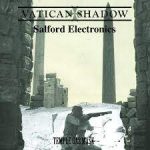
“WHERE WAS GOD ON 9/11?”
Vatican Shadow already blessed Salford Electronics’ industrial face melter ‘Deconstruction’ with a remix treatment, released on the Hospital in 2019, but that didn’t stop Fernow from making the two more in the same manner and putting them on this split tape. Aside of the gunfire present there and in the new collaborative track, as well as the Salford’s solo one, a proper highlight may still be ‘Armed Police Revellers at Stonehenge’, a missing link between the ‘Death Is Unity With God’s ‘Al Qaeda (Branch Davidian)’ deconstructed drone and ‘Opium Crop Airstrikes’ death march.
Physical format:
– Cassette (250 Copies – Regular, 50 Copies – ‘Special Forces’ Edition – 2020, Hospital)
Persian Pillars Of The Gasoline Era (2020)
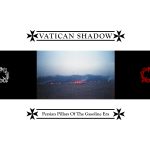
“IMPRISONED A YEAR FOR HIS FAITH, UPON LIBERATION HE COULD NOT BE SILENT. ACQUIESCING TO THE AUTHORITIES, AFTER TORTURE HE DIED A MARTYR.”
“NOBODY MOVE PLEASE. WE ARE GOING BACK TO THE AIRPORT.”
Dominick Fernow’s extreme metal roots are not a secret – from being inspired by Deicide (and wearing their merch on Vatican Shadow press photos) and playing in a couple of his own Black Metal bands, all the way to Prurient having albums on Profound Lore. This time, it was Vatican Shadow delivering its A-game to 20 Buck Spin, seven years after head-banging to ‘Enter Paradise’ in a Boiler Room recording. Proficiently mastered by Justin K. Broadrick, ‘Persian Pillars Of The Gasoline Era’ masterfully bridges the gap between Godflesh and Muslimgauze, perhaps best seen through their affinity for unconventional explorations of Dub music. ‘Persian Pillars…’ is possibly the Vatican Shadow’s most layered work to date, at moments channeling his Berghain 09 mix in the way it sounds like he’s playing a couple of different tracks simultaneously, not only making the layers breathe but also letting the songs branch out properly. ‘Predawn Coup D’etat (Schwarzkopf Duffle Bags Of Rials)’ and ‘Moving Secret Money’, album stand out tracks, play in the aforementioned interzone of Broadrick and Bryn Jones, both highlighted by the massive bass in different roles, but the definitive highlight is a heavier-than-death-in-the-family closer ‘Ayatollah Ferocity (The Refinery At Abadan)’– imagine Ancient Methods remixing Suicide’s remix of Muslimgauze – we need ten more minutes. At least…
Physical format:
– Cassette (2020, 20 Buck Spin)
– CD (2020, 20 Buck Spin)
– Vinyl (Night Vision Glow The Dark Green (20 Buck Spin Website Exclusive) | Crude Oil Ultra Clear w/ Bone / Brown / Black Splatter | Abadan Refinery Splatter Ultra Clear w/ Black Smoke & Gold / Silver Splatter | Clear w/ Orange & Yellow Splatter (Boomkat Exclusive | Spider Hole Black | Nuclear Deal Swirl Neon Green / Red / White Merge w/ Red Splatter – 2020, 20 Buck Spin)
SR-71 Blackbird Survivors (2021)

“NEVER REVEAL THE SECRETS OF THE WORLD’S MOST OMINOUS BIRD.”
A *research* based around the US military’s black project involving a designer ‘spybird’ SR-71, conceived during the Cold War. Even though the tape opens with jet-black synths of ‘Behold The Sr-71 Blackbird’s Nest At Dawn’ which immediately evoke some ‘Remember Your Black Day’ PTSD (in a good way, of course) and continues its high-altitude lane switching on another highlight, ‘Nothing Lived There’, the overall sound comes closest to the noise-infected eclecticism of ‘Death Is Unity With God’ bunker electronics. It’s remarkable how, even this long in its tenure, especially for something that wasn’t supposed to last this long, Vatican Shadow still finds the room to grow without abandoning his signature sound but connecting the dots between the individual factors instead, like having a hundreds of conspiracy theory post-its on the wall and finding a new pattern between them. Never reveal the secrets of the world’s most ominous techno project.
Physical format:
– Cassette (Regular 4x CS Box – 2021, Hospital | 171 copies Special Edition w/ Flexi 7” – 2021, Hospital)
OTHER WORK
COMPILATIONS:
Washington Buries Al Qaeda Leader at Sea: Decks 1-3 (2011) [Compilation]

“BEFORE YOU WHEN YOU CAME OUT OF EGYPT AND WHAT YOU DID TO THE TWO KINGS.”
Contains all three EPs from the series:
Washington Buries Al Qaeda Leader at Sea – Deck 1
Washington Buries Al Qaeda Leader at Sea – Deck 2
Washington Buries Al Qaeda Leader at Sea – Deck 3
Vinyl release (2019) has an additional track featuring Regis.
Physical format:
– Vinyl (300 copies – Blue, Black – 2019, Hospital)
It Stands To Conceal (2013) [Compilation]
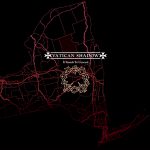
“ARE THE SPIES OF JERICHO STILL HIDDEN WITHIN ITS WALLS?”
Contains one EP and two LPs from the fall of 2012:
Jordanian Descent
Ghosts of Chechnya
Atta’s Apartment Slated for Demolition
*Digital ‘reissue’ from 2013 contains six previously unreleased songs:
Saudi Arabia
United Arab Emirates
Lebanon 1
Lebanon 2
Egypt 1
Egypt 2
Physical format:
– Vinyl (119 copies – Red, White, Blue | 792 copies – Black – 2012, Hospital)
Byzantine Private CIA (2019) [Compilation]

“THE LORD HAS GIVEN YOU THE LAND, AND THAT DREAD OF YOU HAS FALLEN ON US.”
A 2019 double LP reissue consisting of three EPs (in their entirety):
Byzantine Private CIA
Mural of Saddam
Yemeni Commandos
Physical format:
– Vinyl (500 copies – Yellow, Black – 2019, Hospital)
Kuwaiti Airforce (2019) [Compilation]

“BEYOND THE JORDAN, TO SIHON AND OG, WHOM YOU UTTERLY DESTROYED.”
A double LP reissue consisting of:
Kuwaiti Airforce (in entirety)
Vatican Shadow’s tracks from:
The Serpent Carries Him Back Into Paradise
White Eye of Winter Watching
Around the Dragon’s Broken Neck Hangs the Medal of Saint Lazarus
Unreleased Los Angeles Death Cult song (VS x Silent Servant): SNA
Physical format:
– Vinyl (300 copies – Blood Red, 500 copies – Black – 2019, Hospital)
DJ Mixes:
Fabric Promo Mix / Electric Deluxe Podcast / FACT Mag Mix / Berghain 09
Live:
Boiler Room (London, 2013) / Boiler Room (San Francisco, 2014) / RBMA (New York, 2013) / NTS (London, 2013), Varvara Festival (Torino, 2014) / Mosaique (Saint Petersburg, 2019), Dekmantel Festival (2019) / Pluton (Moscow, 2019) / Reaktor Festival (w/ Ancient Methods) (2019)
Remixed by Vatican Shadow:
Addictionproblem – Doom Generation (Vatican Shadow Remix)
Akkord – Typeface / Greyscale (Vatican Shadow’s The World Is Complete)
Anastenaria (Vatican Shadow Version)
Azar Swan + Vatican Shadow & Cut Hands – We Hunger (Vatican Shadow Remix)
Covered In Sand – Heaven’s Gate Suicides (Vatican Shadow Remix)
Dave i.d. – AWIDK (Vatican Shadow Remix)
Endon – Etude for Lynching by Family (Vatican Shadow Remix)
Expander – Volta Forte (Vatican Shadow 4/4 Remix)
Expander – Volta Forte / Once Strong (Vatican Shadow Broken Remix)
The Field – Cupid’s Head (Vatican Shadow Mix)
Function – Psychic Warfare (Vatican Shadow Remix)
Massimo Iannece – The Birth Of Hatred (Vatican Shadow Remix)
My Flower – Rea (Vatican Shadow Remix)
Recondite – Abscondence (Vatican Shadow Remix)
Ron Morelli – Confused Position (Vatican Shadow Remix)
Salford Electronics – Deconstruction (Vatican Shadow Remix)
These Hidden Hands – Ivy (Vatican Shadow Remix)
Violetshaped – Delusory Parasitosis (Vatican Shadow Remix)
IRREGULAR TRACKS:
Cohors Helvetica – w/ Demdike Stare, from Around the Dragon’s Broken Neck Hangs the Medal of Saint Lazarus
Conspiratorial Whispers – from Around the Dragon’s Broken Neck Hangs the Medal of Saint Lazarus
Desert Father – (as Modeselektor Edit), from Modeselektion, Vol. 04
He Held The Victims Responsible (Luxor) – from ‘Cities Outlined In Chalk’, also on Displaced Soundtracks Vol. 2
Rejoice – w/ Telefon Tel Aviv, from #savefabric
SNA – w / Silent Servant (as Los Angeles Death Cult)
Soviet Union’s Vietnam War – from White Eye of Winter Watching
Swords Over Paradise – from Infrastructure Facticity
They Lived A Close Family Life – played by Blush Response in STM 239 mix
The Triumph of Religion – from Around the Dragon’s Broken Neck Hangs the Medal of Saint Lazarus
Part Four:

*REWORK IN PROGRESS. PLEASE BE PATIENT. I WILL EMAIL YOU REGARDING CHANGES.* [April, 2021]
By signing-up for the mailing list, you get my members-only content. In this article, that is Vatican Shadow playlists filtered by styles / moods and an additional essay.
Part Five:
Further Research

The Rainforest Spiritual Enslavement Cheat Sheet
Dominick Fernow’s other projects:
Christian Cosmos + December Magic + Exploring Jezebel Force Publique Congo + Machinegun Warfare + Prurient + River Magic + Sierra Leone Anger + Tortured Hooker + Winter Soldier ——— Ash Pool + Autumn Heart + Cold Cave + Departure Chandelier + Devil’s Dung + Football Rabbit + Jumping Tiger + Macroprurient + Mitochondrial DNA + Los Angeles Death Cult + Nihilist Assault Group + Rainforest Spiritual Enslavement + Roman Cross + Smashed Femur Dance Party + Taylor Bow + Time Crypt + Vegas Martyrs
Muslimgauze:
People on the internet sometimes tend to dismiss Vatican Shadow and bring-up Muslimgauze for elitist reasons – immediately pointing out to it as a person listens to Vatican Shadow unaware of Muslimgauze’s existence. That is completely ignorant since Dominick Fernow never avoided the Muslimgauze discussions and always praised the Bryn Jones’ work directly (words) or indirectly (playing his songs in DJ sets). In an interview with Self-Titled (2013) he also mentioned his favorite Muslimgauze records, which can also be a good starting point for your dive into it: Veiled Sisters, Betrayal, Drug Sherpa, Dome of the Rock. Personally, my favorite is probably Mullah Said so I can’t recommend that one enough.
Dominick Fernow on Muslimgauze:
“I was definitely influenced by his work and, again, I think that part of the genius of this project is that it doesn’t really make any sense. And that’s why it’s compelling to this day. But beyond that, I would say that as much as I was influenced by it at one point, I would say that Vatican Shadow is the opposite of Muslimgauze. Because whether or not it was iconography, he took a position politically at least on a semantic level. Because he included dedications, you know, to certain organisations. So, Vatican is the opposite in the sense that there is no dedication to anyone on any side, that it makes no stands, if it’s iconography or not, it makes no stands within iconography. Or as a political statement, so in this sense it’s a total opposite of Muslimgauze as much as it is influenced by it. But I have a deep respect for his art and it’s incredible, on musical level, to think what he produced, when he made it, how quickly he made it and mostly without computers.” (NSNS, 2018)
“I’m still a big fan of him, although there is a difference between our approaches. He took a very firm position, while my work is based on uncertainty. And in this sense, there is a deviation from what Muslimgauze has done, although without a doubt I am inspired by it. He was the main man in the game mixing ambient, noise, drum-n-bass, jungle, drone… I want to say that he was ahead of time as he created his own musical genre.” (Katacult, 2020)
Originally published: August, 2019
Last Update: May, 2021
Thanks to Pete Lane for helping around the ‘zine digging.
The End
—————————————————————————–
* The aforementioned ‘key takeaways’ are not meant to be portrayed as the Dominick Fernow’s agenda, attitude or stance. They are just my observations correlated with some pre-existing knowledge.
—————————————————————————–
** Media theorist Geert Lovink asserts that blogging is “essentially a nihilist exercise, a digital self-fashioning that actually negates critical engagement, privileging self-promotion over analytical interventions.” Nicolas Carr considers it “a flat noise of opinion – a Socrates’ nightmare.” (Falconer, R., 2015.). While this quote, thanks to social media, can easily be translated to a whole internet, there is a honest intent in this article – it’s conceived in order to champion an inspiring artist and possibly encourage others to do their own (rewarding) research.
—————————————————————————–
*** The header image is sourced and cropped from here. The rest of the images are sourced from the Vatican Shadow’s posters, record artworks and ‘zines. The original images are cropped in order to match the site’s visual direction. In case you’re the author and would like to get some images removed, please let me know here.
**** Support the artist’s music by buying it while they are still alive.

